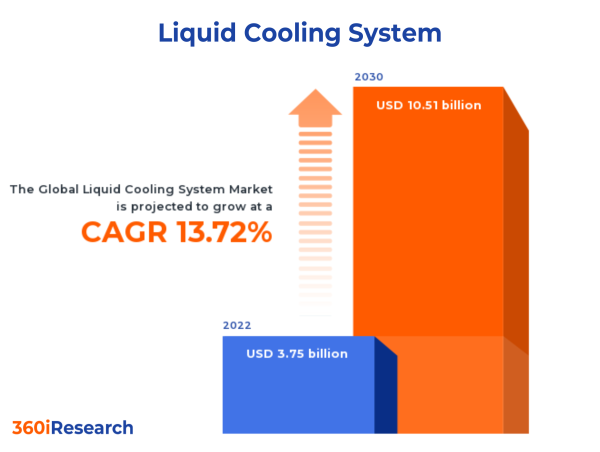The Global Liquid Cooling System Market to grow from USD 3.75 billion in 2022 to USD 10.51 billion by 2030, at a CAGR of 13.72%.
PUNE, MAHARASHTRA, INDIA , November 16, 2023 /EINPresswire.com/ -- The "Liquid Cooling System Market by Type (Compressor-Based System, Liquid Heat Exchanger System), Services (Design & Consulting, Installation & Deployment, Support & Maintenance), Type of Cooling Solution, End-Use - Global Forecast 2023-2030" report has been added to 360iResearch.com's offering.The Global Liquid Cooling System Market to grow from USD 3.75 billion in 2022 to USD 10.51 billion by 2030, at a CAGR of 13.72%.
Request a Free Sample Report @ https://www.360iresearch.com/library/intelligence/liquid-cooling-system?utm_source=einpresswire&utm_medium=referral&utm_campaign=sample
A liquid cooling system is a technique used to keep a computer processor’s temperature low using water as the cooling medium. This cooling mechanism provides efficient cooling and minimizes the noise generated by higher processor speeds. The primary end-use applications for these cooling systems include data centers, high-performance computing (HPC), automotive, industrial machinery, medical equipment, and telecommunications. Rapid growth in data center construction driven by increasing internet usage, cloud computing adoption, e-commerce activities, AI, and big data analytics have increased the demand for liquid cooling systems that offer energy-efficient means for maintaining optimal operating temperatures within data centers. However, a high initial investment is required for installing liquid-cooled infrastructure compared to traditional air-cooled alternatives, and the need for regular maintenance and monitoring of the liquid-cooling components to ensure system integrity and optimal performance hamper the market growth. The emergence of edge computing and technological innovations across the IT sectors is expected to create a lucrative market landscape.
Type of Cooling Solution: High adoption of direct liquid cooling providing maximum cooling performance for highly demanding applications
Direct liquid cooling refers to a system where the coolant arrives in direct connection with the heat-generating components like processors, memory modules or graphics cards. In this process, the heat is efficiently absorbed by the fluid and then transferred away from the components to be dissipated via a heat exchanger or radiator. The primary advantage of direct liquid cooling is its increased efficiency compared to traditional air-cooling methods. Indirect liquid cooling systems utilize an intermediary medium between the coolant and electronic components. These systems typically consist of cold plates attached to heat-generating equipment, which transfer heat to a separate liquid coolant loop. The primary advantage of indirect liquid cooling is its ability to prevent potential damage to electronic components in case of leaks, as the coolant does not come into direct contact with them. Customers who prioritize safety and low maintenance may choose indirect liquid cooling over direct systems while still benefiting from the enhanced efficiency that liquid cooling offers compared to air-cooling methods.
End-Use: Penetration of liquid cooling systems in data centers to manage heat generated by servers
Liquid cooling systems are vital for maintaining the performance and longevity of critical analytical equipment, such as mass spectrometers and electron microscopes. These systems ensure stable temperature control, minimize vibrations, and reduce noise levels. The increasing utilization and adoption of electric vehicles (EVs) has created a demand for efficient thermal management solutions. Liquid cooling systems help maintain optimal battery temperatures while improving vehicle performance and extending battery life. Data centers require high-performance cooling solutions to manage heat generated by servers and other IT equipment. Liquid cooling systems offer superior energy efficiency and can significantly reduce operational costs compared to traditional air conditioning options. In the energy sector, liquid cooling systems find applications in power generation facilities such as solar plants or nuclear reactors, where managing heat loads is essential for efficient operations. Liquid cooling systems are essential in industrial settings for maintaining optimal operating conditions of high-power electronics and machinery. Advanced military equipment such as radar systems, electronic warfare components, and high-performance computers necessitates effective cooling solutions that can withstand harsh environments. High-performance computing (HPC) used in R&D environments requires efficient heat management solutions to maintain peak performance levels. As 5G networks expand, liquid cooling solutions are becoming increasingly important for managing thermal loads in network infrastructure equipment in the telecommunication sector.
Services: High utilization of design & consulting services among organizations looking to implement new or upgraded liquid cooling systems
Design & consulting services are essential for organizations that require expert guidance in selecting the most appropriate liquid cooling solutions based on their specific requirements. This phase encompasses the evaluation of thermal management needs, system architecture design, component selection, and performance optimization. Installation & Deployment services involve the actual implementation of the liquid cooling system within an organization's infrastructure. These services cover everything from pre-installation planning to final system commissioning and integration with other IT components. Support & Maintenance services cater to the ongoing requirements of keeping a liquid cooling system operational, efficient, and up-to-date. This includes regular monitoring, preventive maintenance, troubleshooting, component replacement/upgrade, and end-of-life management.
Type: Compressor-based liquid cooling systems offer higher cooling capacities and precise temperature control
A compressor-based liquid cooling system utilizes a refrigeration cycle to dissipate heat from the target equipment. This type of cooling system is preferred in high-performance computing applications where large amounts of heat are generated and require efficient removal. In terms of need-based preference, compressor-based systems offer both high cooling capacity and precision temperature control. They are ideal for situations demanding critical temperature management or substantial heat dissipation in limited space. Liquid heat exchanger systems transfer excess heat from the target equipment to a secondary fluid medium, typically water or air, through conduction and convection. The need-based preference for liquid heat exchanger systems revolves around their affordability and ease of implementation, especially when compared to compressor-based systems. They are suitable for applications requiring moderate cooling capacities and simple temperature maintenance, such as industrial processes or smaller-scale data centers.
Regional Insights:
The Americas has a significant landscape in the liquid cooling system market owing to the high demand for energy-efficient cooling solutions, which has significantly grown in recent years due to stringent environmental regulations and growing awareness about green technologies. Additionally, a considerable number of data centers are adopting advanced liquid cooling systems to meet their power consumption targets in the region. European Union has also demonstrated a strong interest in sustainable cooling technologies, given their commitment to reduce greenhouse gas emissions initiatives. Additionally, several EU-based companies are investing heavily in R&D projects aimed at developing next-generation liquid cooling solutions. Middle Eastern countries are increasingly recognizing the importance of efficient cooling systems due to soaring temperatures and rapid urbanization that place high demands on existing infrastructures. The APAC has led in terms of research activities on liquid-cooling technology investment in liquid cooling systems to reduce energy consumption and increase operational efficiency. Growing adoption of liquid cooling systems due to rising demands from industries such as Information Technology (IT), telecommunications, and automotive sectors, and government support in the adoption of energy-efficient technologies through various initiatives has further fueled the market demand in the region.
FPNV Positioning Matrix:
The FPNV Positioning Matrix is essential for assessing the Liquid Cooling System Market. It provides a comprehensive evaluation of vendors by examining key metrics within Business Strategy and Product Satisfaction, allowing users to make informed decisions based on their specific needs. This advanced analysis then organizes these vendors into four distinct quadrants, which represent varying levels of success: Forefront (F), Pathfinder (P), Niche (N), or Vital(V).
Market Share Analysis:
The Market Share Analysis offers an insightful look at the current state of vendors in the Liquid Cooling System Market. By comparing vendor contributions to overall revenue, customer base, and other key metrics, we can give companies a greater understanding of their performance and what they are up against when competing for market share. The analysis also sheds light on just how competitive any given sector is about accumulation, fragmentation dominance, and amalgamation traits over the base year period studied.
Key Company Profiles:
The report delves into recent significant developments in the Liquid Cooling System Market, highlighting leading vendors and their innovative profiles. These include ALFA LAVAL AB, AMETEK.Inc., Aquila, Inc., Asetek, Inc., Asetek, Inc. A/S, Aspen Systems Inc., Boyd Corporation, CoolIT Systems, Inc., Dober, Fujitsu Limited, GIGA-BYTE Technology Co., Ltd., Green Revolution Cooling Inc., Hitachi Group, Koolance, Inc., Laird Thermal Systems, Inc., LiquidStack Holding B.V., Midas Green Technologies LLC, Mikros Technologies, Motivair Corporation, Parker Hannifin Corp., Rittal GmbH & Co. KG, and Schneider Electric SE.
Inquire Before Buying @ https://www.360iresearch.com/library/intelligence/liquid-cooling-system?utm_source=einpresswire&utm_medium=referral&utm_campaign=inquire
Market Segmentation & Coverage:
This research report categorizes the Liquid Cooling System Market in order to forecast the revenues and analyze trends in each of following sub-markets:
Based on Type, market is studied across Compressor-Based System and Liquid Heat Exchanger System. The Liquid Heat Exchanger System is further studied across Liquid-to-Air Systems and Liquid-to-Liquid Systems. The Liquid Heat Exchanger System is projected to witness significant market share during forecast period.
Based on Services, market is studied across Design & Consulting, Installation & Deployment, and Support & Maintenance. The Design & Consulting is projected to witness significant market share during forecast period.
Based on Type of Cooling Solution, market is studied across Direct and Indirect. The Direct is projected to witness significant market share during forecast period.
Based on End-Use, market is studied across Analytical Equipment, Automotive, Data Centers, Energy, Healthcare, Industrial, Military, Research & Development, and Telecommunication. The Healthcare is projected to witness significant market share during forecast period.
Based on Region, market is studied across Americas, Asia-Pacific, and Europe, Middle East & Africa. The Americas is further studied across Argentina, Brazil, Canada, Mexico, and United States. The United States is further studied across California, Florida, Illinois, New York, Ohio, Pennsylvania, and Texas. The Asia-Pacific is further studied across Australia, China, India, Indonesia, Japan, Malaysia, Philippines, Singapore, South Korea, Taiwan, Thailand, and Vietnam. The Europe, Middle East & Africa is further studied across Denmark, Egypt, Finland, France, Germany, Israel, Italy, Netherlands, Nigeria, Norway, Poland, Qatar, Russia, Saudi Arabia, South Africa, Spain, Sweden, Switzerland, Turkey, United Arab Emirates, and United Kingdom. The Europe, Middle East & Africa commanded largest market share of 38.29% in 2022, followed by Americas.
Key Topics Covered:
1. Preface
2. Research Methodology
3. Executive Summary
4. Market Overview
5. Market Insights
6. Liquid Cooling System Market, by Type
7. Liquid Cooling System Market, by Services
8. Liquid Cooling System Market, by Type of Cooling Solution
9. Liquid Cooling System Market, by End-Use
10. Americas Liquid Cooling System Market
11. Asia-Pacific Liquid Cooling System Market
12. Europe, Middle East & Africa Liquid Cooling System Market
13. Competitive Landscape
14. Competitive Portfolio
15. Appendix
The report provides insights on the following pointers:
1. Market Penetration: Provides comprehensive information on the market offered by the key players
2. Market Development: Provides in-depth information about lucrative emerging markets and analyzes penetration across mature segments of the markets
3. Market Diversification: Provides detailed information about new product launches, untapped geographies, recent developments, and investments
4. Competitive Assessment & Intelligence: Provides an exhaustive assessment of market shares, strategies, products, certification, regulatory approvals, patent landscape, and manufacturing capabilities of the leading players
5. Product Development & Innovation: Provides intelligent insights on future technologies, R&D activities, and breakthrough product developments
The report answers questions such as:
1. What is the market size and forecast of the Liquid Cooling System Market?
2. Which are the products/segments/applications/areas to invest in over the forecast period in the Liquid Cooling System Market?
3. What is the competitive strategic window for opportunities in the Liquid Cooling System Market?
4. What are the technology trends and regulatory frameworks in the Liquid Cooling System Market?
5. What is the market share of the leading vendors in the Liquid Cooling System Market?
6. What modes and strategic moves are considered suitable for entering the Liquid Cooling System Market?
Read More @ https://www.360iresearch.com/library/intelligence/liquid-cooling-system?utm_source=einpresswire&utm_medium=referral&utm_campaign=analyst
Mr. Ketan Rohom
360iResearch
+ 1 530-264-8485
[email protected]





